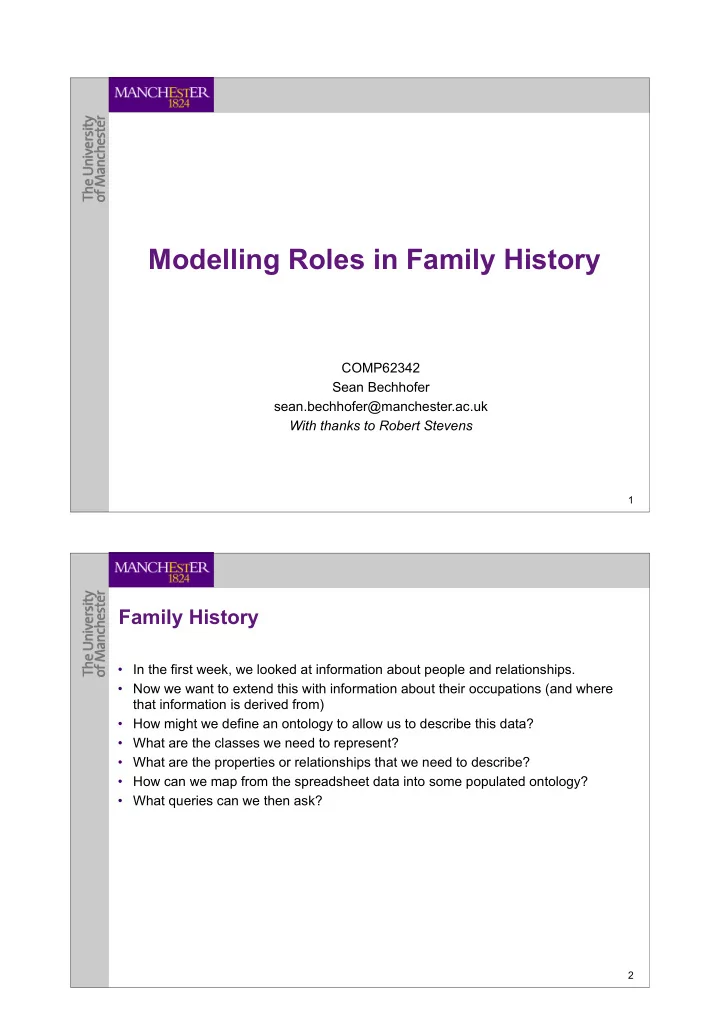

Modelling Roles in Family History COMP62342 Sean Bechhofer sean.bechhofer@manchester.ac.uk With thanks to Robert Stevens 1 Family History • In the first week, we looked at information about people and relationships. • Now we want to extend this with information about their occupations (and where that information is derived from) • How might we define an ontology to allow us to describe this data? • What are the classes we need to represent? • What are the properties or relationships that we need to describe? • How can we map from the spreadsheet data into some populated ontology? • What queries can we then ask? 2
• Name of Person – Given Name – Surname – Possibly Married name • Date of Birth – If known • Occupation – Year – Source – (Additional Notes) • Sex? 3 Modelling in OWL • Recall that OWL allows us to describe – Individuals. – Classes (of Individuals). – Relationships between Individuals or Properties of Individuals. � • What are our Individuals here? • What are the Classes • What are the Properties/Relations? 4
Basic Data • Each Person has – Given Name – Surname – Date of Birth • Some Persons (Women) may also have – Married Surname � • OWL provides Datatype properties that allow us to associate data values with Individuals. – Strings, numbers etc. 5 Occupations • We are assuming that we have a hierarchy of occupations or roles (not all of the things that people are listed as doing are necessarily occupations) • This is a simple taxonomy. • We might, at some point, be concerned about modelling this more completely, e.g. through descriptions of the roles, but for current purposes, an asserted hierarchy is fine. � • However, a key question is how we associate people with the occupations/roles that they are playing. 6
Modelling Occupations: Attempt #1 Class: Person Class: Role Class: Butcher SubClassOf: Role � Individual: W.G.Bright Types: Person, Butcher 7 Modelling Occupations: Attempt #2 Class: Person Class: Role Class: Butcher SubClassOf: Role � ObjectProperty: hasRole � Individual: Butcher-1 Types: Butcher Individual: W.G.Bright Types: Person Facts: hasRole Butcher-1 8
Named and Anonymous Individuals • OWL allows us to make statements about particular named individuals. • Fred has a cat called Tibbs. Individual: Fred � Types: Person � Facts: hasPet Tibbs � � � Individual: Tibbs � Types: Cat � � • We can also refer to anonymous individuals • Fred has a cat, but we don’t know anything about it Individual: Fred • This representation of incomplete Types: Person that hasPet information can be useful when we don’t some Cat know (or don’t care) about the particular individual. 9 Modelling Occupations: Attempt #3 Class: Person Class: Role Class: Butcher SubClassOf: Role � ObjectProperty: hasRole � Individual: W.G.Bright Types: Person that hasRole some Butcher 10
Modelling Occupations: Attempt #4 Class: Person Class: Role Class: Butcher SubClassOf: Role Class: RolePlayed � ObjectProperty: playsRole ObjectProperty: hasRole � Individual: W.G.Bright Types: Person that playsRole some (RolePlayed that hasRole some Butcher) 11 Modelling Sex: Male and Female • People are Male or Female – For the purposes of this model we will take a simplified view and not consider transgender/androgeny etc. – Thus every person is either Male or Female and not both � � A. Subclasses of Person Male, Female, with Individuals being asserted as instances of those classes • Disjointness and Covering Axioms B. Two distinct Individuals Male, Female with a functional ObjectProperty hasSex C. Classes Male, Female, a functional ObjectProperty hasSex with Individuals being asserted to be related to anonymous Individuals of those classes. • Disjointness and Covering Axioms 12
Modelling Male and Female • Incomplete information? • Extensibility? • Shared “maleness”? • Definitions of Man and Woman? � • How can we tell if people are Male or Female in the data? 13 Modelling Dates • The data states a date for the occupation – Start date? – End date? – Some kind of duration? � • A simple approach here is to provide a DatatypeProperty that associates the year (as an integer) with the RolePlayed instance – An advantage of considering the RolePlayed as an object. – Other data types are available. e.g. for dates � • Limitations? 14
Provenance • It is often important to maintain the provenance of information. – Where does this fact come from? • The data includes this for most of the facts – Census Records – Birth Records – Death Records – Marriage Records • We can provide additional attributes on the RolePlayed Individuals stating where the information came from � • As with Sex there are possible choices – Distinct Individuals: Census, BirthRecord, DeathRecord etc. – Classes for Source types – Classes for Source types with Anonymous Individuals. – Would we ever want to name these? 15 Named or Anonymous RolePlayed Object? Individual: William_George_Bright_1901 Types: playsRole some (RolePlayed and hasRole some Butcher and hasYear value "1929"^^integer and hasSource some MarriageRecord) Individual: James_Bright_1809 Facts: playsRole rolePlayed_001 � Individual: rolePlayed_001 Types: RolePlayed and (hasRole some Seaman) Facts: hasYear “1839”^^integer 16
Recommend
More recommend